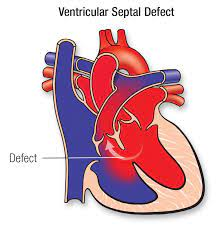Coarctation of the aorta, aortic stenosis, and pulmonic stenosis are congenital heart defects in which category?
Obstructive defects
Mixing defects
Decreased pulmonary blood flow
Increased pulmonary blood flow
The Correct Answer is A
Obstructive congenital heart defects involve the presence of narrowing or constriction in various parts of the heart or major blood vessels. In the case of coarctation of the aorta, there is a narrowing or constriction in the aorta, which can obstruct blood flow. Aortic stenosis involves the narrowing of the aortic valve, and pulmonic stenosis involves the narrowing of the pulmonary valve. These defects create obstacles to the normal flow of blood out of the heart, leading to increased pressure within the heart and affecting blood circulation.
The other categories mentioned are:
B. Mixing defects: These defects involve abnormal mixing of oxygenated and deoxygenated blood within the heart, typically due to septal defects like atrial septal defect (ASD) or ventricular septal defect (VSD).
C. Decreased pulmonary blood flow: These defects are characterized by reduced blood flow to the lungs, such as in the tetralogy of Fallot.
D. Increased pulmonary blood flow: These defects involve increased blood flow to the lungs, often due to shunting of blood from the left side of the heart to the right side, as seen in atrial septal defects or ventricular septal defects.
Nursing Test Bank
Naxlex Comprehensive Predictor Exams
Related Questions
Correct Answer is ["A","E"]
Explanation
The findings that indicate a diagnosis of Acute Kidney Injury (AKI) in a 5-year-old patient are:
A. Peripheral Edema: Peripheral edema, or swelling in the extremities, can be a sign of fluid retention due to impaired kidney function in AKI.
E. Oliguria: Oliguria, which is a decreased urine output, is a common sign of AKI. It can be defined as a urine output of less than 0.5 mL/kg/hour in children.
The other findings mentioned (B, C, and D) do not specifically indicate a diagnosis of AKI:
B. Blood pressure of 112/70: The blood pressure within this range is not necessarily indicative of AKI on its own.
C. Potassium level of 4.7 (normal: 3.5-5.0 mmol/L): While abnormal potassium levels can be associated with AKI, a potassium level of 4.7 mmol/L is within the normal range.
D. Diarrhea: Diarrhea is not typically a direct symptom of AKI but may be seen in various other conditions or as a result of electrolyte imbalances associated with kidney dysfunction.
Correct Answer is A
Explanation
Infants with congenital heart defects, including VSD, may have increased caloric needs due to the added work of their hearts. Congestive heart failure can lead to poor weight gain and failure to thrive. Therefore, increasing the caloric density of the formula is a common approach to providing the necessary nutrition for growth and development. This can be achieved by using specialized high-calorie infant formulas or fortifying breast milk.
The other options are not the primary supportive measures for an infant with congestive heart failure in this context:
B. Oxygen therapy to ensure oxygen saturation is > 98%: While oxygen therapy may be necessary for infants with congenital heart defects, it is not the primary supportive measure to address failure to thrive. Oxygen therapy primarily aims to ensure adequate oxygenation but does not directly address caloric intake.
C. Sedatives to keep the infant from crying: The use of sedatives is not a typical approach to managing congestive heart failure in infants. Addressing the underlying cause, optimizing nutrition, and providing supportive care are more appropriate strategies.
D. Emergent surgical correction of the defect: Surgical correction of a VSD is typically considered for specific indications, such as significant hemodynamic compromise, but it is not the first-line intervention for all cases of VSD, especially if the primary concern is failure to thrive. Treatment decisions for VSD are made based on the specific clinical presentation and severity of the defect.

Whether you are a student looking to ace your exams or a practicing nurse seeking to enhance your expertise , our nursing education contents will empower you with the confidence and competence to make a difference in the lives of patients and become a respected leader in the healthcare field.
Visit Naxlex, invest in your future and unlock endless possibilities with our unparalleled nursing education contents today
Report Wrong Answer on the Current Question
Do you disagree with the answer? If yes, what is your expected answer? Explain.
Kindly be descriptive with the issue you are facing.
